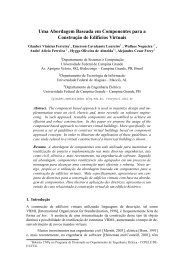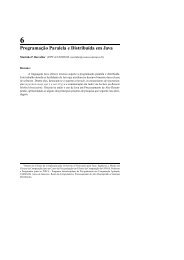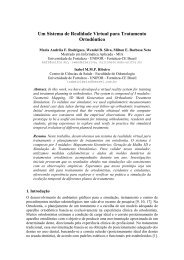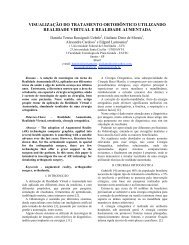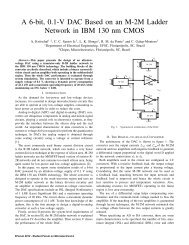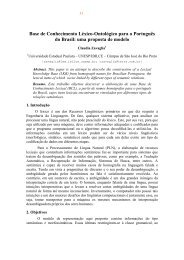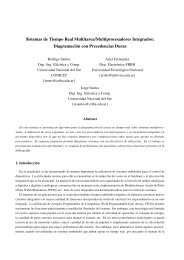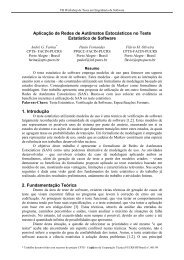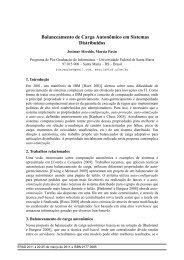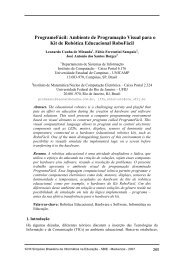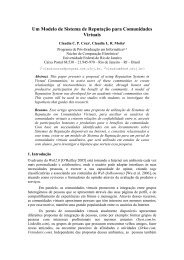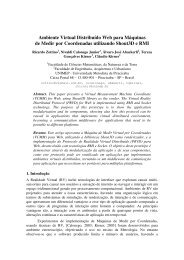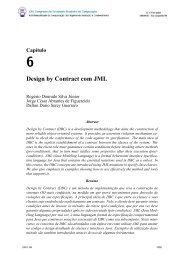Sobre a correlaç˜ao de números fuzzy: uma aplicaç˜ao a populaç ...
Sobre a correlaç˜ao de números fuzzy: uma aplicaç˜ao a populaç ...
Sobre a correlaç˜ao de números fuzzy: uma aplicaç˜ao a populaç ...
Create successful ePaper yourself
Turn your PDF publications into a flip-book with our unique Google optimized e-Paper software.
132 V. M. Cabral, R. A. C. Prata, L.C.Barros<br />
[C] α = {(x,qx+r) ∈ R 2 : x = (1−s)a α 1 +sa α 2,s ∈ [0,1]};<br />
[B] α = q[A] α +r, para qualquer α ∈ [0,1] e<br />
µ (x) = µ ( B A x−r<br />
q ), ∀x ∈ R.<br />
Os α-níveis <strong>de</strong> A+ C B são dados por<br />
[A+ C B] α = {(x,y) ∈ R : µ gC (A,B)(x,y) ≥ α}<br />
= {(x,y) ∈ R : sup µ (x,y) ≥ α}<br />
C<br />
z=x+y<br />
= {(x,y) ∈ R : sup µ (x).X A {qx+r=y}(x,y) ≥ α}<br />
z=x+y<br />
= {x+y ∈ R : µ A (x) > α,qx+r = y}<br />
= {(q +1)x+r ∈ R : µ A (x) > α}<br />
= (q +1){x ∈ R : µ A (x) > α}+r<br />
= (q +1)[A] α +r.<br />
Note que quando q = −1 a soma dos <strong>números</strong> <strong>fuzzy</strong> completamente correlacionados<br />
A e B é número real r. Além disso, se r = 0, A+ C B = 0<br />
Exemplo 2 Quando f(x) = q<br />
x +r, com x > 0 e q = 0, os <strong>números</strong> <strong>fuzzy</strong> A e B<br />
são chamados hiperbolicamente correlacionados. Neste contexto, a distribuição<br />
<strong>de</strong> possibilida<strong>de</strong> conjunta C <strong>de</strong> A e B tem a seguinte função <strong>de</strong> pertinência<br />
on<strong>de</strong>,<br />
µ C (x,y) = µ A (x)X { q<br />
x +r=y}(x,y) = µ B (y)X { q<br />
x +r=y}(x,y) (3)<br />
X { q<br />
x +r=y}(x,y) =<br />
⎧<br />
⎨1<br />
se q<br />
x +r = y<br />
⎩<br />
0 se q<br />
x +r = y<br />
a função característica da hipérbole {(x,y) ∈ R2 : q<br />
x +r = y}.<br />
Neste caso temos:<br />
[A] α = [aα 1,aα 2];<br />
[C] α = {(x, q<br />
x +r) ∈ R2 : x ∈ [a α 1,a α 2]};<br />
[B] α = q<br />
[A] α +r = [ q<br />
a α 2<br />
+r, q<br />
a α 1<br />
µ (x) = µ ( B A q<br />
x−r ), ∀x ∈ R.<br />
+r];<br />
Os α-níveis <strong>de</strong> A. C B são dados por<br />
[A. C B] α = {(x,y) ∈ R : µ hC (A,B)(x,y) ≥ α}



